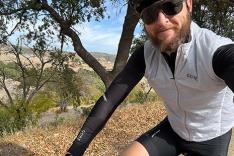
While power training may be all the rage, the high tech toy of choice for the majority of cyclists is the heart rate monitor. One important question to ask is exactly at what heart rate should one be working at to optimize training time and efficiency? The first thing to understand is the different ways by which scientists and coaches base their heart rate training zones.
It is indisputable that heart rate monitoring remains the dominant mode of fitness monitoring for the majority of cyclists. Ever since Francesco Moser pioneered the use of heart rate monitors (HRMs) to closely track his preparations for the Hour Record in 1984, HRMs have become almost as ubiquitous as a water bottle for both elite and everyday cyclists alike. The cardiovascular system is a complex interplay of many things going on inside your body, but heart rate remains the simplest indicator of strain on the entire cardiovascular.
More: What You Need to Know About Training With a Heart-Rate Monitor
Cardiovascular Physiology 101
Cardiac output is simply the overall volume of blood that is being pumped out of your heart each minute, with maximal cardiac output estimates of 25 L/min for untrained individuals and possibly 35+ L/min for highly aerobically fit athletes. In turn, cardiac output is simply your heart rate multiplied by your stroke volume, or how much blood is pumped by your heart with each beat.
While cardiac output is ultimately the measure we would really like to have as a measure of training intensity. However, this is not common because, while heart rate is simple to measure using either a heart rate monitor or simply counting your pulse with a stopwatch, it is much harder to measure stroke volume. There are some non-invasive and some highly invasive methods, but they are generally done only in an exercise physiology laboratory like mine.
More: Understanding Your Heart Rates and Exercise
Therefore, heart rate is what we use for tracking exercise intensity much of the time, but it is not perfect. Heart rate is also affected by your nervous system, as can be seen when you are at the start line of a bicycle race and your heart rate is already at 150 bpm before the starting gun even goes off! Or you could be tired and pushing yourself harder than ever, yet your heart rate will only reach 160 bpm as compared to your normal 175 bpm at threshold. In both cases, your nervous system is sending signals to your heart that overrides your body's physiological demands for cardiac output.
More: Use a Heart-Rate Monitor to Find Your Threshold
Maximal Heart Rate
How best to use heart rate then? There have been numerous attempts to peg the ideal heart rate at which to exercise in order to maximize training efficiency. Some point to an idea of basing things on maximal heart rate, such as training zones set as particular percentage of maximal heart rate. For example, endurance efforts might be at 60-75% of maximal heart rate, tempo efforts at 75-82%, etc. For these zones to work, the critical assumption is that you have an accurate knowledge of your maximal heart rate.
If you have been in a gym, then you have likely seen the most common way for determining maximal heart rate, and that is by subtracting your age from 220. However, as Matt McNamara wrote last week, there is little actual scientific backing for the concept of a maximal heart rate based on an equation of 220 -- age.
Here is an example from my own cycling career on the dangers of basing maximal heart rate, or indeed overall training, on a generic template. In my early years of competitive cycling, when I was an undergraduate in my late teens, my maximal heart rate should have been around 220-20, or 200 beats per minute. However, in all the tests I did on myself in the lab and on the bike, my heart rate NEVER exceeded 175 beats per minute, and often was much lower.
- 1
- of
- 2








Discuss This Article